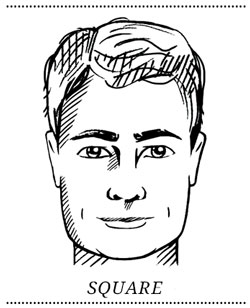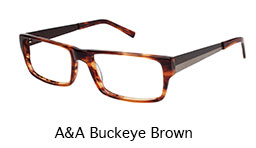Quick question: Would you let an optician style your hair?
Sure, a refraction chair might bear a passing resemblance to a barber's chair—and I have had kids ask me in all earnestness if they're going to get their hair cut, too—but, barring a situation where your optician also happened to be an experienced hairdresser, you probably wouldn't.
That doesn't stop a lot of people from letting their hairdresser act as an optician, though.
Do a Google search on "face shapes" and "glasses" and you'll find a plethora of charts, diagrams, and celebrity photos detailing exactly what size and shape frames you should choose to most flatter your face. For the most part, these guidelines are a pretty good rule of thumb, and will outline exactly what type of frames will most flatter your face...
...if you're a woman.

See, the thing about most of these guides is that they originated in the world of hairdressing, applying the same artistic concepts that a beautician would consider when helping a woman determine the best hairstyle for her face size and shape. In a way, it makes a certain amount of sense. There are certain things most women want to achieve when it comes to modifying the way their faces look: For the most part, women with shorter than average faces will want to try and elongate them, women with longer than average faces will want to shorten them, women with wider than average faces will want to narrow them, etc. etc., regardless of whether that change comes from a new hairstyle or a new pair of frames. Any woman or man reading this, though, can probably see where the problem in all of this arises: The way a woman wants to look usually isn't the way a man wants to look.
Consider this piece of advice for choosing a pair of frames that I've plucked from one of many internet guides, and see if you can figure out the problem:
For individuals with a strong jawline, choose frames to soften and round out the face.
See the problem with that? Hopefully, most people reading this do. But many entry-level opticians and those who've never worked in any field that requires attention to aesthetics might not. So, here's the big revelation that 99.999 percent of online eyeglass-selection guides always miss:
No man wants to have his features softened.
True, most women would rather have traditionally masculine features downplayed, like prominent brows, powerful jawlines, and strong chins. The guides you'll find online (and even in some opticianry books) will give you some great advice for choosing the proper frames to help women enhance their more feminine features and downplay their more masculine ones; the problem is that these guides make no differentiation in choosing glasses for men vs. women.
The online guides' biggest offense comes when giving advice for square faces. The square face, like the round face, is in equal proportions of length to height; because of this, it tends to be among the shortest face shapes, with little space between the eyes, nose, and mouth, with a large, prominent forehead and a strong, blocked-off jawline. People of a certain age probably remember references in adventure serials and literature to square jawed heroes. At one time, this was considered the prototypical tough guy face shape. Many online guides point to Brad Pitt as "the" square-faced celebrity, but anyone who got even a C in geometry can see that his face is more classically oblong; as square faces have "gone out of fashion," it's a subtle way to try and make square faced men feel good about themselves by convincing them (and everyone else) that they just have shortened versions of Brad Pitt's face. For a more accurate idea, think George Reeves, the original Superman.
What frames, then, to select for the square faced man? After all, the guides all instruct you on how to choose frames to soften, smooth, and feminize the square face. All well and good for a woman; what about your male patients, though?
ROUND FRAMES
Round frames are often one of the go-to frames for online guides. They are the most efficient at rounding out a powerful jaw and adding softness to the face. Most men with strong jawlines or squat faces probably won't like the effect that round frames have on them. Unless the man in question is trying to achieve a particular look—retro, scholarly—or has a particularly high minus, these probably aren't the best choice of frames.

SQUARE FRAMES
Square frames are a tricky choice. On the one hand, for men who want to accentuate their angles as much as possible, no other frame shape is going to accentuate squareness than a square. On the other hand, the proportions of square frames will make most square faced men's faces appear artificially smaller and shorter, overpowering them in the process. It's a trade off that has to be considered.
OVAL FRAMES
Oval frames are a good middle of the road choice for square faces, and one of my personal favorite go-tos. The rounded edges are good for high minuses, but not so rounded out that they'll soften the face too much the way that round frames will. They're shorter than round frames, too, which means they won't overpower the face and take away from the length too much. Ovals are also an appropriate choice for guys who want to achieve an old-fashioned look but who don't want to make the aesthetic sacrifices that round frames demand.

RECTANGLE FRAMES
Rectangular frames are, like square frames, a tricky choice. On paper, they're the perfect selection—short enough not to overwhelm the face, with sharp edges to accentuate the angles of the jawline. Most of my square-faced male patients end up choosing them. The design of many rectangular frames can prove problematic, though. Consider that, for high-power myopes, the resultant edge thickness might put you into a position of form over function; consider, too, that for presbyopes needing a PAL and individuals who want a good range of vision, most manufacturer's squat, teeny rectangles just aren't practical choices, all cosmetic considerations aside. For hyperopes and low-power myopes, though, rectangular frames are a wonderful middle point between looks and function, and those with generous B measurements are excellent choices for patients in need of a PAL.

For newer opticians using guides to help choose frames for women, the information you've been reading is probably a good guidepost. For your male patients, though, it's worth taking a look at outside sources that consider what most men want to achieve cosmetically, in order to help find the frames that will give them the best intersection of appearance and functionality.

Preston Fassel was born in Houston, Texas and grew up between St. Charles, Missouri and Broken Arrow, OK.
In 2009, Preston graduated Summa Cum Laude with a degree in Liberal Arts. In 2011, he graduated Cum Laude from Sam Houston State University with a Bachelor’s of Science.
Preston currently works as an Optician in the Houston area. His interest in the history of eyewear goes back to his time in high school, when he developed an interest in all things vintage.
In addition to his writing for The 20/20 Opticians Handbook and 20/20 Magazine, Preston has also been featured in Rue Morgue magazine, where he is a recurrent reviewer of horror and science-fiction DVDs. His fiction writing has been featured three times in Swirl magazine, the literary arts journal of Lone Star College and Montgomery County. An essay on the life and death of British horror actress Vanessa Howard is scheduled to appear in the Spring issue of the quarterly horror journal, Screem.
Preston lives in Conroe, Texas with his wife, Kayleigh, and his ego, Ted.
This content is sponsored by A&A Optical.













